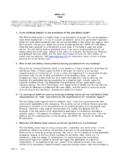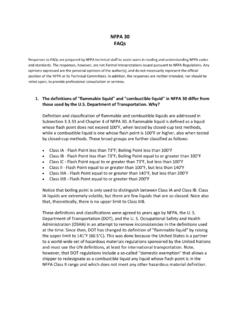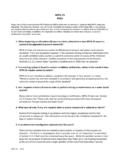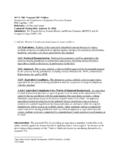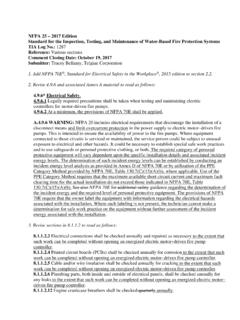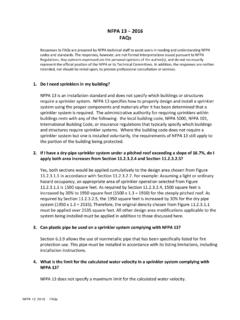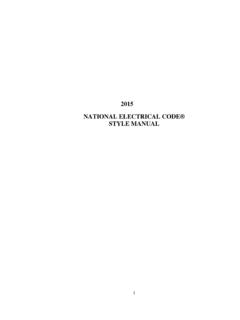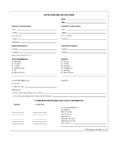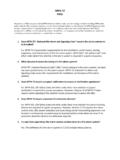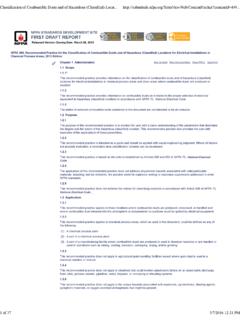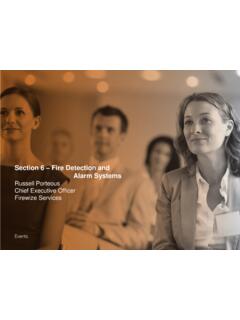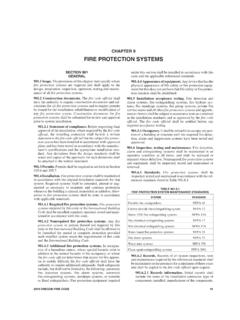Transcription of National Fire Alarm and Signaling Code
1 JOBNAME: No Job Name PAGE: 16 SESS: 2 OUTPUT: Mon Aug 22 14:07:34 2011 NFPA 72 National fire Alarm and Signaling Code2013 EditionIMPORTANT NOTE: This NFPA document is made available foruse subject to important notices and legal disclaimers. These noticesand disclaimers appear in all publications containing this documentand may be found under the heading Important Notices and Dis-claimers Concerning NFPA Documents. They can also be obtainedon request from NFPA or viewed at : An asterisk (*) following the number or letterdesignating a paragraph indicates that explanatory materialon the paragraph can be found in Annex other than editorial are indicated by a verticalrule beside the paragraph, table, or figure in which thechange occurred.
2 These rules are included as an aid to theuser in identifying changes from the previous edition. Whereone or more complete paragraphs have been deleted, the de-letion is indicated by a bullet ( ) between the paragraphs reference in brackets [ ] following a section or paragraphindicates material that has been extracted from another NFPA document. As an aid to the user, the complete title and editionof the source documents for extracts in mandatory sections ofthe document are given in Chapter 2 and those for extracts ininformational sections are given in Annex H. Extracted textmay be edited for consistency and style and may include therevision of internal paragraph references and other refer-ences as appropriate.
3 Requests for interpretations or revisionsof extracted text shall be sent to the technical committee re-sponsible for the source reference in parentheses ( ) following a paragraph indi-cates the committee responsibility for that section or para-graph. Committee acronyms are keyed to the acronyms shownwith the committee lists at the front of the on referenced publications can be found inChapter 2 and Annex 1 72covers the application, installation, location,performance, inspection, testing, and maintenance of firealarm systems, supervising station Alarm systems, public emer-gency Alarm reporting systems, fire warning equipment andemergency communications systems (ECS)
4 , and their provisions of this chapter apply throughout theCode unless otherwise * purpose of this Code is to define the means ofsignal initiation, transmission, notification, and annunciation;the levels of performance; and the reliability of the varioustypes of fire Alarm systems, supervising station Alarm systems,public emergency Alarm reporting systems, fire warningequipment, emergency communications systems, and Code defines the features associated with thesesystems and also provides information necessary to modify orupgrade an existing system to meet the requirements of a par-ticular system Code establishes minimum required levels of per-formance, extent of redundancy.
5 And quality of installationbut does not establish the only methods by which these re-quirements are to be *This Code shall not be interpreted to require a level ofprotection that is greater than that which would otherwise berequired by the applicable building or fire systems shall be classified as follows:(1) fire Alarm systems(a) Household fire Alarm systems(b) Protected premises (local) fire Alarm systems(2) Supervising station Alarm systems(a) Central station (service) Alarm systems(b) Remote supervising station Alarm systems(c) Proprietary supervising station Alarm systems(3) Public emergency Alarm reporting systems(a) Auxiliary Alarm systems local energy type(b) Auxiliary Alarm systems shunt communications systems shall be classifiedas follows.
6 (1) One-way emergency communications systems(a) Distributed recipient mass notification systems(b) In-building fire emergency voice/ Alarm communica-tions systems(c) In-building mass notification systems(d) Wide area mass notification systems(2) Two-way emergency communications systems(a) In-building emergency communications reference or implied reference to a particular typeof hardware shall be for the purpose of clarity and shall not beinterpreted as an intent and meaning of the terms used in this Codeshall be, unless otherwise defined herein, the same as those ofNFPA 70, National Electrical Code.
7 Otherwise noted, it is not intended that the pro-visions of this document be applied to facilities, equipment,structures, or installations that were existing or approved forconstruction or installation prior to the effective date of those cases where it is determined by the authorityhaving jurisdiction that the existing situation involves a dis-tinct hazard to life or property, retroactive application of theprovisions of this document shall be in this Code shall prevent the use of systems,methods, devices, or appliances of equivalent or superiorquality, strength, fire resistance, effectiveness, durability, andsafety over those prescribed by this 16 National fire Alarm AND Signaling CODE2013 EditionJOBNAME: No Job Name PAGE: 17 SESS: 2 OUTPUT: Mon Aug 22 14:07:34 documentation shall be submitted to the au-thority having jurisdiction to demonstrate systems, methods, devices, or appliances that arefound equivalent shall be fire Risk Analysis.
8 [ROP-2a] *A fire risk analysis shall be permitted to be used to de-termine the protection of the fire Alarm and Signaling systembased on its location, building features, and anticipated risktolerances where specifically permitted by this Code.[ROP-2a] fire risk analysis conducted in shall be docu-mented.[ROP-2a] Units and units of measure in this Code are presented in units (inch-pound units). presented, the International system (SI) of unitsfollow the inch-pound units in both systems of units are presented, either sys-tem shall be acceptable for satisfying the requirements in both systems of units are presented, users of thisCode shall apply one set of units consistently and shall notalternate between *The values presented for measurements in this Codeare expressed with a degree of precision appropriate for prac-tical application and enforcement.
9 It is not intended that theapplication or enforcement of these values be more precisethan the precision extracted text contains values expressed in onlyone system of units, the values in the extracted text have beenretained without conversion to preserve the values establishedby the responsible technical committee in the source Code Adoption Code shall be admin-istered and enforced by the authority having jurisdiction des-ignated by the governing authority.(See Annex F for sample word-ing for enabling legislation.)Chapter 2 Referenced documents or portions thereof listed in thischapter are referenced within this Code and shall be consid-ered part of the requirements of this NFPA fire Protection Association,1 Batterymarch Park, Quincy, MA 10,Standard for Portable fire Extinguishers,2010 11,Standard for Low-, Medium-, and High-ExpansionFoam,2010 13,Standard for the Installation of Sprinkler Systems, 25,Standard for the Inspection, Testing, and Maintenanceof Water-Based fire Protection Systems,2011 37.
10 Standard for the Installation and Use of StationaryCombustion Engines and Gas Turbines,2010 70 , National Electrical Code ,2011 75,Standard for the Protection of Information TechnologyEquipment,2009 90A,Standard for the Installation of Air-Conditioning andVentilating Systems,2012 110,Standard for Emergency and Standby Power Systems,2010 111,Standard on Stored Electrical Energy Emergency andStandby Power Systems,2010 170,Standard for fire Safety and Emergency Symbols, 601,Standard for Security Services in fire Loss Prevention,2010 720,Standard for the Installation of Carbon Monoxide(CO) Detection and Warning Equipment,2012 780,Standard for the Installation of Lightning ProtectionSystems,2011 1221,Standard for the Installation, Maintenance, and Useof Emergency Services Communications Systems,2010 1600 ,Standard on Disaster/Emergency Management andBusiness Continuity Programs,2010 1620,Standard for Pre-Incident Planning,2010 Other ANSI National Standards Insti-tute, Inc.
